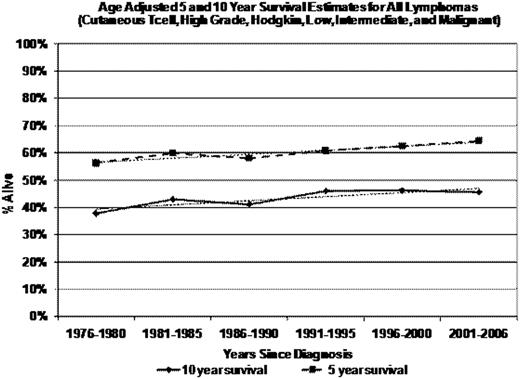Abstract
Abstract 4527
The incidence of lymphoma has doubled in the past 3 decades in the US and most western countries. Since the advent of multi-drug chemotherapy, studies have shown improvement in survival in specific diagnostic groups such as diffuse large B-cell lymphomas. However, there have been few studies showing the impact of evolving therapies on survival for the total burden of lymphoma patients. We assessed survival for an aggregate population of all patients presenting with lymphoma to a regional tertiary university hospital over the past 3 decades.
To assess the magnitude of improvement in survival for patients with lymphoma over the past 3 decades.
We analyzed data from the Penn State Hershey Medical Center Cancer Registry, selecting all cases diagnosed with lymphoma by ICD-0-3 codes from Jan 1st 1976 to Dec 31st 2006. Five and ten year (yr) absolute survival rates during five time periods [group (gp) 1: 1976-1980, gp 2: 1981-1985, gp 3: 1986-1990, gp 4: 1996-2000, gp 5: 2001-2006] were obtained by using conventional period analysis (PA). In addition, a period Cox Proportional Model (CPH) was fit to the data, allowing for survival risk estimates of 5 yr survival, statistical testing of time periods, and adjustments for age at diagnosis. SAS v 9.1 was used to obtain estimates, with Brenner's PERIOD macro used for PA and PHREG used for CPH.
Of 2843 patients, Hodgkin's lymphoma accounted for 17%, high grade lymphoma 4%, intermediate grade lymphoma 29%, low grade lymphoma 17%, cutaneous T-cell lymphoma 6%, chronic lymphocytic leukemia and small lymphocytic lymphoma (CLL/SLL) 13%, malignant lymphoma not otherwise specified (NOS) 14%. Median age was 56 yr and mean was 52 yr with a standard deviation (SD) of 20.9 yr. Median follow up was 4 yr and mean was 6 yr with SD 6.5 yr. Approximately 25% (N=700) survived beyond 10 yr. CPH adjusted for age demonstrated a 5 yr improvement among all lymphomas of 8%, Hazard Ratio (HR)=1.31, 95%, p=0.0192, between gp 5 and gp 1. Consistent improvements in 5 yr survival were detected for intermediate grade lymphoma (15%, HR=1.5, p=0.0219), high grade lymphoma (40%, HR=12.83, p<0.0001), and malignant lymphoma NOS (19%, HR=1.8, p=0.069) comparing gp 5 to gp 1. Changes in survival rates for Hodgkin's lymphoma, low grade lymphoma, CLL/SLL, and cutaneous T-cell lymphoma were not significant. Results for conventional PA were similar. There was a 7% improvement in 5 yr survival between gp 5 and gp 1 for all patients with lymphoma. However, improvement in 10 yr survival between available time intervals was minimal. For the PA, significant improvement in 5 yr survival was seen for intermediate grade lymphoma (24%), high grade lymphoma (28%), malignant lymphoma NOS (19%) comparing gp 5 to gp 1. Interestingly, cutaneous T-cell lymphoma showed a descriptive decline in both 5 yr and 10 yr survival of 29% and 14% respectively.
There has been a significant improvement of 8% in overall 5 yr survival in lymphoma patients over the past 3 decades after adjusting for age. There was an improvement in survival in both intermediate and high grade groups. There was a trend towards declining survival in cutaneous T cell lymphoma. This could be attributed to diagnostic drift with changing classification and to the fewer number of cases diagnosed in the earlier years as compared to later years.
No relevant conflicts of interest to declare.
Author notes
Asterisk with author names denotes non-ASH members.


